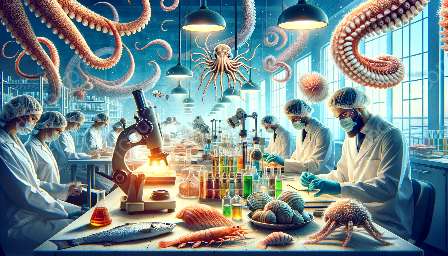Seafood is a valuable source of nutrition for billions of people worldwide. However, the perishable nature of seafood makes quality control a critical aspect of its processing and distribution. In this topic cluster, we will explore the various techniques and methods used for quality control in seafood processing, with a specific focus on seafood quality control and assessment within the context of seafood science.
Understanding Seafood Quality Control and Assessment
Quality control in seafood processing involves the implementation of measures to ensure that the seafood products meet specified standards of safety, quality, and traceability. It encompasses a range of activities, including monitoring, inspection, and testing, aimed at identifying and addressing potential quality issues throughout the production and distribution chain. Seafood quality assessment involves the evaluation of various attributes, such as freshness, taste, texture, nutritional value, and absence of contaminants, to determine the overall quality of the seafood products.
Monitoring and Inspection Techniques
One of the fundamental quality control techniques in seafood processing is the establishment of monitoring and inspection procedures at critical points in the supply chain. These may include regular checks of temperature, pH levels, and moisture content to prevent microbial growth, as well as visual inspection for any signs of spoilage or contamination. Additionally, the use of modern sensor technologies, such as IoT-based monitoring systems and RFID tags, enables real-time tracking of seafood products, ensuring compliance with quality and safety standards.
Testing and Analysis Methods
Various testing and analysis methods play a crucial role in seafood quality control and assessment. Microbiological testing, including the detection of pathogens and spoilage microorganisms, is essential to ensure the safety of seafood products. Chemical analysis techniques, such as chromatography and spectroscopy, help in identifying contaminants, toxins, or adulterants that may compromise the quality of the seafood. Moreover, sensory evaluation by trained panels and consumers provides valuable insights into the organoleptic properties of seafood, ensuring that the products meet consumer expectations.
Utilization of Advanced Technologies
Advancements in technology have significantly contributed to enhancing the efficiency and accuracy of seafood quality control. Non-destructive techniques, such as ultrasound imaging and magnetic resonance imaging (MRI), enable the assessment of internal attributes, such as texture and integrity, without altering the seafood products. Furthermore, rapid detection methods, including PCR-based assays and biosensors, facilitate the quick identification of contaminants and allergens, thereby expediting the quality control process.
Regulatory Compliance and Standards
Regulatory bodies and international organizations, such as the Food and Agriculture Organization (FAO) and the Codex Alimentarius Commission, play a pivotal role in establishing and enforcing seafood quality and safety standards. Compliance with these standards is paramount for seafood processors, and adherence to Good Manufacturing Practices (GMP) and Hazard Analysis and Critical Control Points (HACCP) principles is essential to ensure the production of safe and high-quality seafood products.
Integration of Sustainability Considerations
As the demand for sustainably sourced seafood continues to rise, quality control techniques in seafood processing are increasingly focusing on sustainability aspects. This involves traceability measures to verify the origin and fishing practices, as well as certification schemes, such as the Marine Stewardship Council (MSC) certification, which attest to the sustainable sourcing of seafood. By integrating sustainability considerations into quality control, seafood processors contribute to the responsible utilization of marine resources.
Research and Innovation in Seafood Quality Control
The field of seafood quality control and assessment is continually evolving, with ongoing research and innovation driving advancements in quality control techniques. This includes the development of novel preservation methods, such as high-pressure processing and active packaging, to extend the shelf life of seafood products while maintaining their quality. Additionally, the application of blockchain technology for supply chain transparency and traceability is poised to revolutionize seafood quality assurance in the near future.
Conclusion
Quality control techniques for seafood processing are essential for ensuring the safety, quality, and integrity of seafood products. By leveraging advanced monitoring, inspection, testing, and technological tools, seafood processors can uphold high standards of quality and compliance. Furthermore, the integration of sustainability considerations and ongoing research efforts contribute to a comprehensive approach to seafood quality control and assessment, benefiting both the industry and consumers.

